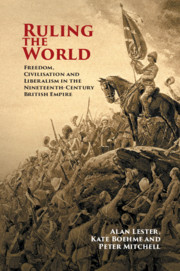Book contents
- Ruling the World
- Ruling the World
- Copyright page
- Dedication
- Contents
- Figures
- Maps
- Acknowledgements
- Introduction
- Part I 1838: The Year of Freedom
- 1 Setting the Scene for Emancipation
- 2 Managing Expectations
- 3 Political Freedom
- 4 Settler Liberties
- 5 Free Trade, Famine and Invasion
- 6 Steam and Opium
- Conclusion to Part I: An Empire of Freedom?
- Part II 1857: The Year of Civilisation
- Part III 1879: The Year of Liberalism
- Appendix: Cast of Characters
- Notes
- Index
Conclusion to Part I: An Empire of Freedom?
from Part I - 1838: The Year of Freedom
Published online by Cambridge University Press: 17 December 2020
- Ruling the World
- Ruling the World
- Copyright page
- Dedication
- Contents
- Figures
- Maps
- Acknowledgements
- Introduction
- Part I 1838: The Year of Freedom
- 1 Setting the Scene for Emancipation
- 2 Managing Expectations
- 3 Political Freedom
- 4 Settler Liberties
- 5 Free Trade, Famine and Invasion
- 6 Steam and Opium
- Conclusion to Part I: An Empire of Freedom?
- Part II 1857: The Year of Civilisation
- Part III 1879: The Year of Liberalism
- Appendix: Cast of Characters
- Notes
- Index
Summary
The British Empire of 1838 was transitioning in many ways all at once. The basis of its economy was shifting, from slave-produced tropical commodities towards emigrant-produced temperate products, although opium remained a constant; its geography was shifting, from twin circuits of trade in the West and East Indies towards new centres of gravity in the vast terrains of the southern hemisphere and North America; and its mode of governance was shifting from the autocratic military elite which had violently seized new colonies from Britain’s enemies towards a bureaucracy more accountable to settlers overseas and reformers at home.
- Type
- Chapter
- Information
- Ruling the WorldFreedom, Civilisation and Liberalism in the Nineteenth-Century British Empire, pp. 183 - 186Publisher: Cambridge University PressPrint publication year: 2021

